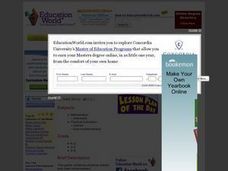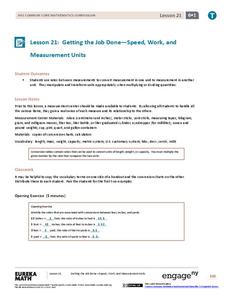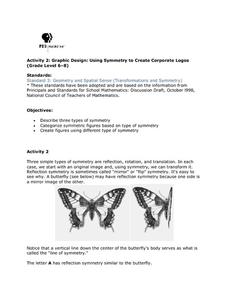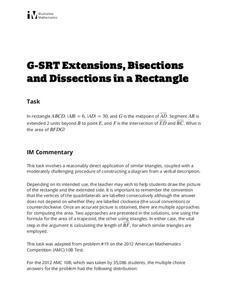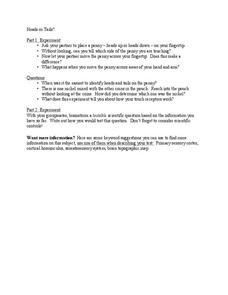CK-12 Foundation
Trigonometric Functions of Negative Angles
When is the trigonometric value of a negative angle the same as the positive angle? Pupils compare the values of trigonometric functions for different angles and their negatives. The interactive resource provides a visual display to make...
Curated OER
Wheeling and Dealing NPS Wheel
A collection of three worksheets create a "Wheeling and Dealing NPS Wheel" when properly cut out and fastened together, This activity would be perfect when used with any study of how our water sources get polluted.
Curated OER
More and Less Handfuls
Working as a pair, two kindergartners will sit at a table and will pick two handfuls of counters. They will combine their individual handfuls into one, and count their own selection. They will then draw and record their count on a record...
Willow Tree
Solving Quadratic Equations
Polynomials are full of solutions! Learners understand that the degree determines the number of solutions. Examples show quadratic equations solved by factoring and by using the quadratic formula. A cubic equation is even mixed in for...
Curated OER
Balloon Math: A Game for All Levels
Here is a game that combines exercise with math skills. In this mathematics and P.E. instructional activity, learners hold balloons that have a number written on them, and for a set time do not let the balloons hit the ground. They must...
Curated OER
The Grapes of Wrath: QAR--Question/Answer Relationship
Chapter nine of John Steinbeck's The Grapes of Wrath provides the text for an exercise that asks readers to think deeply about the items the Joads left behind and what these items might represent.
Curated OER
Writing Linear Equations in Different Forms
Can your class write linear equations three different ways? Here is a study guide that includes slope-intercept, standard, and point-slope forms. Learners are given the slope and a point on the line, or two points and are asked to write...
Illustrative Mathematics
Making a Clock
Have a fun time teaching children to read analog clocks with this whole-group math activity. Using large sets of the numerals 1-12 and 0, 5, 10...55, the teacher creates a large clock on either the carpet or the white board, explaining...
EngageNY
Getting the Job Done—Speed, Work, and Measurement Units
How do you convert from one measurement to another? Pupils use unit rates to convert measurements from one unit to another in the 21st segment in a 29-part series. They convert within the same system to solve length, capacity, weight,...
Great Books Foundation
The Road Not Taken
Every time you make a choice, it prevents another option from taking shape. Spend some time analyzing "The Road Not Taken" by Robert Frost with a reading activity that includes four discussion questions that recall evidence from the text.
Curated OER
Erosion
Students are able to identify the causes and effects of erosion. They hypothesize ways to help curb erosion. Students are able to identify ways being used now to curb erosion. They are shown two different types of erosion, by putting...
Curated OER
Grid Drawing Project Self-Assessment
This is a self-assessment for use with a grid drawing project, but could be modified to fit any number of similar projects. Learners answer each question as a way to reflect and assess their own art work. Learning how to objectively...
MENSA Education & Research Foundation
Pi Day Fun!
In this multi-faceted introduction to pi, participants perform a bevy of pi-related activities. Ranging from measuring household items to singing pi songs and reading pi stories, this fun and non-intimidating resource serves to bring up...
PBS
Using Symmetry to Create Corporate Logos
Young mathematicians investigate the use of symmetry in graphic design. After first learning about reflection, translational, and rotational symmetry, children use this new knowledge to identify symmetry in letters of the alphabet and...
Illustrative Mathematics
Right Triangles Inscribed in Circles I
One of the basic properties of inscribed angles gets a triangle proof treatment in a short but detailed exercise. Leading directions take the learner through identifying characteristics of a circle and how they relate to angles and...
Illustrative Mathematics
Extensions, Bisections and Dissections in a Rectangle
Gaining practice in translating a verbal description into a diagram and then an equation is the real point of this similar triangles exercise. Once the diagram is drawn, multiple methods are provided to reach the conclusion. An effective...
E Reading Worksheets
Tone Worksheet 5
A speaker's attitude toward his or her subject matter determines the tone of a piece of literature. Interpret the tone of four different poems, as well as their meanings, with supporting textual details.
Center for Learning in Action
Gases
Explore the properties of gases through one activity and two investigations in which super scientists observe the changes gas makes when encountering different conditions.
Channel Islands Film
Cache: Lesson Plan 2 - Grades 4-6
Class members will dig this activity that has them trying their hand at recovering artifacts. Groups are assigned a section of a sandbox, carefully uncover the artifacts in their section, and then develop theories about who might have...
University of Minnesota
Heads or Tails
How exactly does touch help us identify items? Students test this question by feeling a coin without moving their fingers and trying to determine if it is heads or tails. They test their accuracy by rubbing their fingers on the coins....
Curated OER
Pastel Landscape
A horizon line is one that helps artists establish space and dimension in their pictures. Young artists use pastels (chalks) to draw landscapes that use a horizon line. They draw the image with black chalk fist, color it in, and finally...
Reading Resource
/ie/ Word List
This activity, the second in a series of 16 resources designed to develop the awareness skills needed to detect the vowel sounds in words, asks readers to identify and highlight the /ie/ sound in a list of 39 words. After identifying the...
DiscoverE
Working with Watermills
Water is a powerful force; harness it through watermills. The task at hand is to create a simple watermill that functions in flowing water for at least three minutes. Scholars work together in teams to design and construct such a...
Advocates for Human Rights
Push and Pull Factors and Human Rights
What factors might make a person want to emigrate from their home country? What factors might make a person want to immigrate to a new country? Class members study the various waves of immigration to the US, looking at data about the...






